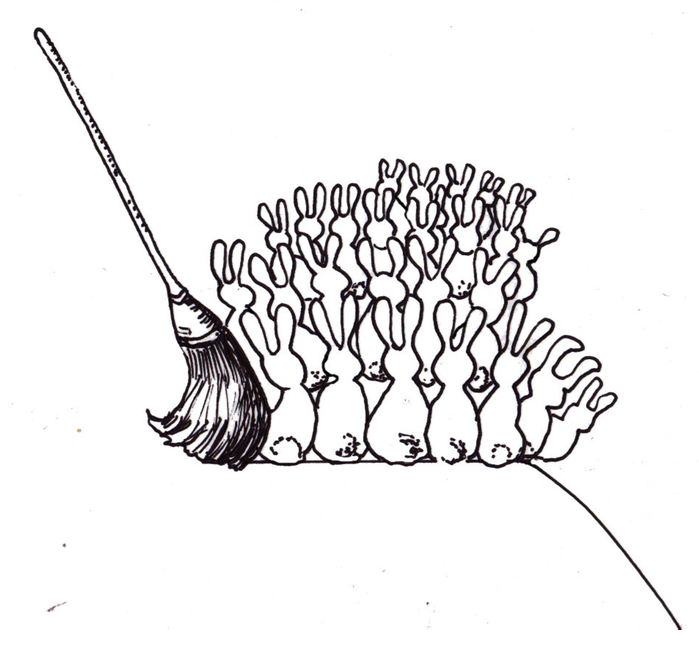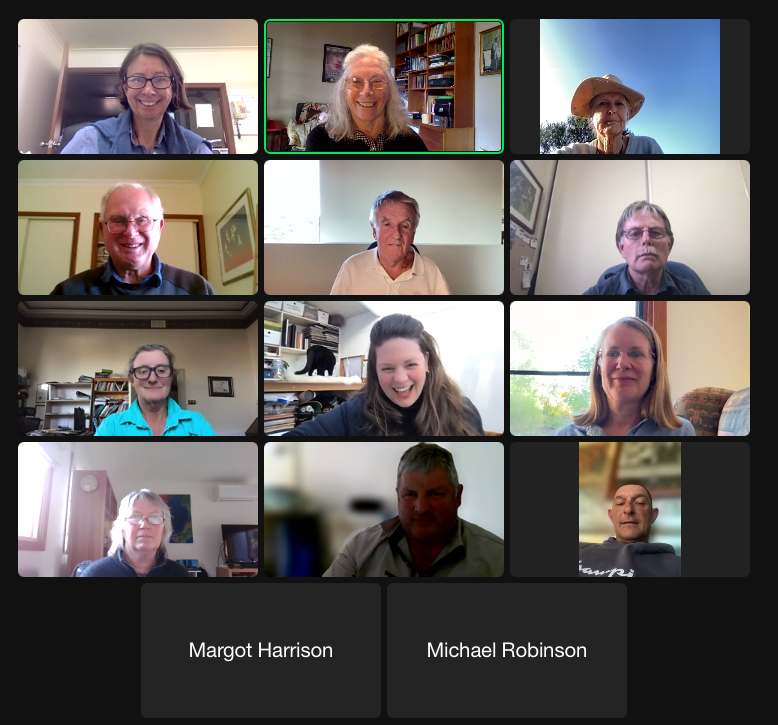Post webinar news 2023-09
Rabbit Sweep
- a BLG Rabbit Action Group Project.

This newsletter is for those interested in the development of a whole-of-peninsula rabbit control project. If you do not want to receive the newsletter, please unsubscribe below.
Late September 2023 News
In recent weeks, there have been 'chats' going on as we try to identify ideas and people that can help with our mission to produce an excellent strategic plan for rabbit ontrol on the Bellarine.
Our project has attracted attention and we have been awarded a grant that will help pay for some of the services of the Together Apart (they are contributing half their usual 'charity' cost and we are very grateful and pleased to give them some rewards). We have a small amount after that to ensure our technical goodies continue to work and for a little bit of extra advice when it's needed. Otherwise, we have a lot of support for which we are all very grateful.
We also applied for some funds to publish whatever we produce in the middle of next year and here's hoping we will be successful with this.
A pleasing development from the Bellarine Landcare Group's perspective is that we and the Victorian Rabbit Action Network (VRAN) are working out how to narrow the places where rabbit advice is offered online. We want that advice to be provided in a transparent way, so when there are disagreements about an item we want to provide good evidence and science to help users choose what to do. Our aim, from the BLG/RAG side, is to have a single, really reliable site so it is much easier for us all to work together.
On September 26 we had a very interesting webinar. You can watch this by going to
https://www.bellarinemac.org.au/images/Rabbits%2Fwebinar-230926.mp4
Webinar about the DAL

Our webinar was designed to help us better understand what is known now as the DAL and, in particular, how it might help us. The Rabbit Sweep is very keen to take guidance from this document and help all concerned recognise that rabbits are very relevant to the health and sustainability of our very special environment..
The DAL has been gazetted by the Victorian Government and determines a number of rules for implementation in the next 50 years on the Peninsula. We were very fortunate to have Professor Lawrence St Leger lead this conversation. He was involved in the Combined Bellarine Community Associations work towards this report.
The full document is available at https://www.gazette.vic.gov.au/gazette/Gazettes2023/GG2023S428.pdf
and an 'exec' summary of some relevant bits is here.
A very important issue that immediately arose in the webinar was that everyone's health actually depends upon subsistence in a healthy environment. This issue of health is a major contribution for Lawrence and you can read some of the world's most read documents at:
https://www.researchgate.net/profile/Lawrence-St-Leger
So the policies that affect our health should be those that receive the most immediate attention. The Bellarine attracts homemakers, and tourists, and people who value the environment and many of those people come for the wonderful nature and super fresh air on offer. The Rabbit Sweep has a chance to suggest a number of strategies that will need to be adopted by the entities identified in the DAL that have an obligation to work on DAL principles.
So the next issue for the webinar was the concern about how the DAL has perhaps 'frozen' a lot of the Bellarine as potential development land. This means that many landholders have land that will, of course rise in value, but not to the extent they hoped. Land prices and values will change as a result of this.
But the reason this matters is because there is a lot of land being poorly managed on the Peninsula.
Landholders who do not use their land tend to lease it out to others. These others often have short term leases and accordingly short term uses for the land. For them, they say, it is not worth investing money to maintain the land, let alone to improve it. We do not blame the lessees but perhaps we could have a better system on the Peninsula?
We do not know how much those who lease land actually know about how to farm or support their land. We suspect many who lease land do know how to do the right thing but have no need to when there is a lot of land and it might cost them money!
As one local farmer points out - we have tax incentives to help people do the right thing - don't they want the benefits of them? Perhaps the tax issue raises an opportunity for us to work with the Government and the local councils to devise special conditions that would help the landholders, the lessees, and the environment?
Imagine if the leases were for terms that were long enough to attract sustainability issues. Imagine that there were some sort of rewards for those who leased land and actively maintained or even improved it.
This issue of caring for country is not new. The Peninsula has been occupied for a very long time but has suffered a lot of damage in a fairly short time. Dried up or polluted waterways have caused so many of our fantastic trees to die and despite the planting of so-called corridors for smaller animals and birds, there are lots of gaps that are too big for them to traverse. Isolated grants to landholders do not always achieve the results they could if they were co-ordinated.
We are keen to hear from you if you have an idea that is well-formed or one that needs to be worked on. Our business is ideas - so please don't hesitate!
We are keen to hear from you at
Finally, Kate Baxter from the Together Apart has offered us this wonderful summary of the event:

Rabbit Sweep Exec summary of the DAL
BELLARINE PENINSULA STATEMENT OF PLANNING POLICY
Peri-urban and regional areas
Peri-urban areas are important to Traditional Owners for the protection of Country and the maintenance of spiritual and cultural practices. … We must balance the growth of Geelong, metropolitan Melbourne and regional cities and towns with the need to conserve and enhance distinctive areas and landscapes.
A sustainable approach to planning and managing peri-urban and regional areas recognises, conserves and enhances each of their unique values and distinctive attributes – their landscape character, biodiversity and environment, Aboriginal cultural heritage and historic heritage – and ensures that development responds appropriately to these values and attributes
The attributes that qualified the Bellarine Peninsula declared area as a distinctive area - Outstanding environmental significance:
"The endangered native flora and fauna located in pockets of this area, particularly along river corridors. This habitat consists of various plant species, including the endangered Bitter-bush, Coast wirilda and Trailing Coast Poa. The wetlands across the Bellarine Peninsula are Ramsar-protected wetlands and form part of a global network for migratory birds. The wetlands are home to several unique and threatened species."
United Nations Sustainable Development Goals
The Bellarine Statement of Planning Policy (SPP) aims to achieve the conservation and improvement of biodiversity values and for governments to work with communities, the private sector, other non-government groups and communities to implement its vision, objectives and strategies.
[Bellarine Landcare is in a great position to help with this.]
The Bellarine Peninsula SPP requires implementation by responsible public entities (RPEs) as the agencies or bodies responsible for managing land in the declared area.
Responsible Public Entities (RPEs)
Barwon Coast Committee of Management, Barwon Water, Bellarine Bayside Coastal Management, Bellarine Community Health Ltd, Bellarine Peninsula Elderly Peoples Home Society Inc, Borough of Queenscliffe, City of Greater Geelong, Corangamite Catchment Management Authority, Water Parks Victoria, Secretary (within the meaning of the Conservation, Forests and Lands Act 1987) to the Department of Environment and Climate Change Action (formerly Department of Environment, Land Water and Planning), Southern Rural Water, The Head (Transport for Victoria), Victorian Planning Authority, Victorian Fisheries Authority, VicTrack, Working Heritage Inc.
Objectives (binding on Registered entities)
In accordance with section 46AV(1)(c) of the PE Act: the objectives in this SPP are binding on RPEs but while the strategies in this SPP are not binding on RPEs: they are recommendations to which RPEs must have regard.
By 2072, our vision for the Bellarine Peninsula declared area is that the Wadawurrung, governments, public land managers, businesses, community groups, residents and visitors work together to ensure the area’s unique values and distinctive attributes – the things people love about the area – are protected and enhanced and are not degraded over time.
Environment and biodiversity: Indigenous plants and animals flourish within a natural environment that is healthy, well cared for and cherished by local communities and visitors. The area’s unique marine and waterway environments – the Ramsar wetlands of Swan Bay, Lake Connewarre and the Barwon Estuary – are healthy. A network of well-managed parks and reserves and private lands and gardens support fragile ecosystems and biodiversity.
Objective 2
The following objective is binding on responsible public entities: To conserve and enhance the significant biodiversity, ecological and environmental values of the declared area.
Objective 6 - binding
The following objective is binding on responsible public entities. To enable a diverse, sustainable and strong regional economy (including responsible tourism, agriculture and natural resource industries) that protects and promotes the declared area’s landscape significance, environment and biodiversity, agriculture and Wadawurrung living cultural heritage and historic heritage values.
Green breaks and urban-rural interface areas:
Maintaining green breaks between the declared area’s settlements is important. As shown on Map 3, the green breaks together with the protected settlement boundaries will help conserve environmental and cultural heritage attributes, strategic infrastructure (such as water utilities), agricultural land and other natural resources from encroachment by urban development. Within the declared area, green breaks are mostly rural land zoned as Farming Zone, Rural Conservation Zone, Public Conservation and Recreation Zone or Rural Living Zone.
Objective 8 - binding
The following objective is binding on responsible public entities. To plan and manage the sustainable development of settlements in the declared area consistent with the protection of the area’s landscape significance, environment and biodiversity values, Wadawurrung living cultural heritage and historic heritage values and consistent with the unique character and hierarchy designation of each settlement.